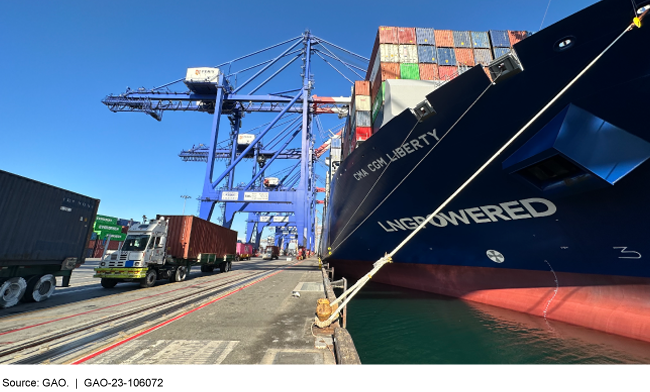Supply Chain: Updated Freight Handbook Could Enhance Stakeholder Decision-Making
Fast Facts
The COVID-19 pandemic caused congestion of cargo containers at U.S. maritime ports. Many ports struggled to unload large cargo ships in a timely manner, which delayed the delivery of goods.
To help deliver goods more efficiently, freight stakeholders, such as port authorities and railroads, build inland facilities where they transfer cargo containers between trains and trucks.
The Department of Transportation's Freight and Land Use Handbook provides information and best practices for planning and establishing such facilities. However, we found that this handbook has not been updated since 2012. We recommended that DOT create a plan to update it.
Cargo Containers Being Unloaded From a Vessel at a Marine Container Terminal in Los Angeles, CA

Highlights
What GAO Found
Freight stakeholders (e.g., port authorities, railroads, industry associations, and state and local agencies) told GAO they develop inland facilities, which GAO refers to as inland intermodal freight facilities, to increase supply chain mobility, reduce marine terminal congestion, and process freight. Freight stakeholders use such facilities to transfer cargo containers between modes of transportation (e.g. ships, trains, trucks) to enable cargo to move through the supply chain.
Example of Container Transport through an Inland Intermodal Facility

The Federal Highway Administration (FHWA) developed a Freight and Land Use Handbook in 2012 as a resource to better inform freight stakeholders about considerations for establishing land-based facilities for freight mobility. For example, the handbook provides information, case studies, and best practices on planning and establishing freight facilities. However, the handbook is outdated, does not reflect new emerging markets, such as e-commerce, and many stakeholders are not aware of it. For instance, 11 of 17 stakeholder groups told GAO they were not aware of the handbook. FHWA officials stated they intend to begin updating the handbook by the end of fiscal year 2023, but have no plan with project milestones to guide the effort.
FHWA officials told GAO they have not proactively communicated the 2012 handbook with freight stakeholders in recent years due to its age. According to DOT, FHWA conducted three regional workshops with stakeholders on 2012 on freight and land use. Moving forward, FHWA officials stated that they plan to involve freight stakeholders in updating the handbook. However, they have not developed a strategy for engaging the different groups of stakeholders or communicating the updated handbook more broadly. Developing a plan to update the handbook can ensure FHWA can better assist freight stakeholders with establishing inland intermodal freight facilities and addressing any associated challenges. Also, by developing a strategy that communicates FHWA's updated Freight and Land Use Handbook, FHWA can raise awareness and better ensure the tools and resources in the updated handbook are reaching relevant freight stakeholders.
Why GAO Did This Study
The COVID-19 pandemic led to cargo container congestion at maritime ports and warehouses. These challenges delayed the delivery of goods to consumers and led to fluctuating prices. In February 2021, the President issued Executive Order 14017, calling for improved resilience of U.S. supply chains.
The House Committee Report accompanying the Department of Homeland Security Appropriations Bill, 2022, includes a provision for GAO to review factors for establishing inland intermodal freight facilities. This report addresses how freight stakeholders use inland intermodal freight facilities and the extent to which FHWA has updated and communicated about its freight and land use handbook, among other objectives.
GAO reviewed DOT's strategic plans and guidance, interviewed officials; and analyzed DOT data on intermodal freight facilities as of July, 2022, the most recent data available during GAO's review. GAO interviewed a non-generalizable selection of 17 stakeholders from state, and local agencies, port authorities, private entities, and associations.
Recommendations
GAO is recommending that DOT (1) develop a plan with timelines to update its Freight and Land Use Handbook, and (2) develop a strategy to communicate the updated handbook to freight stakeholders. DOT concurred with both recommendations.
Recommendations for Executive Action
| Agency Affected | Recommendation | Status |
|---|---|---|
| Department of Transportation | The Secretary of Transportation should ensure that the FHWA Administrator develops and documents a plan with timelines to update the Freight and Land Use Handbook. (Recommendation 1) |
The U.S. Department of Transportation concurred with this recommendation in April 2023 and described planned steps it would take to implement it. Department of Transportation officials estimated that they would complete these efforts in September 2023. As of November 1, 2023, DOT developed a Project Management Plan that includes timelines to update the Freight and Land Use Handbook. Developing and documenting a plan to update the Freight and Land Use Handbook better positions the Department of Transportation to provide freight stakeholders useful information on establishing inland intermodal freight facilities and associated challenges.
|
| Department of Transportation | The Secretary of Transportation should ensure that the FHWA Administrator develops a strategy to communicate FHWA's updated Freight and Land Use Handbook with freight stakeholders. (Recommendation 2) |
The U.S. Department of Transportation concurred with this recommendation in April 2023 and described planned steps it would take to implement it. The Department of Transportation told GAO in September 2023 it was developing a strategy to communicate the Freight and Land Use Handbook after completing planned workshops with freight industry stakeholders. In March 2024, the Department of Transportation shared their Freight and Land Use Handbook Communication Strategy. Developing a strategy to communicate the Freight and Land Use Handbook better positions the Department of Transportation to raise awareness for this resource and helps ensures the tools in the handbook reach relevant freight stakeholders as they plan and establish inland intermodal freight facilities.
|
